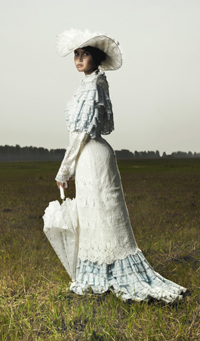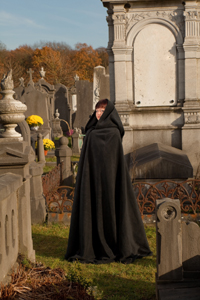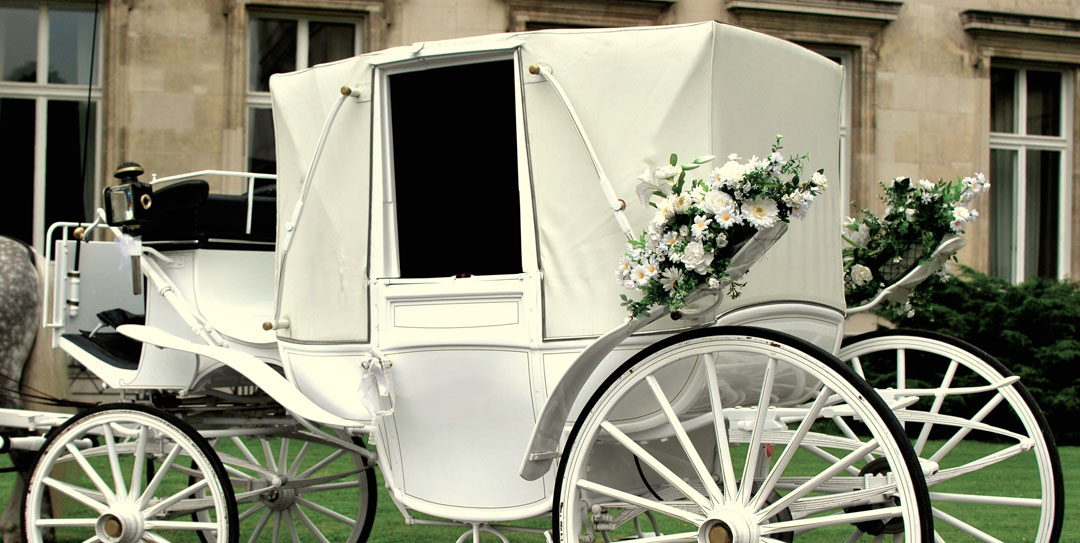CEREMONIES
 Wedding Ceremonies
Wedding Ceremonies
Wedding ceremonies most often followed the formula set forth by the parties’ religious body. The Church of England used the language with which many were familiar, namely, “With this ring I thee wed, with my body I thee worship, and with all my worldly goods I thee endow: In the Name of the Father, and of the Son, and of the Holy Ghost. Amen.”
Legally, however, no particular language was specified, and the parties could elect whatever language they chose to signify commitment to a permanent and legally binding union.
 Wedding Attire
Wedding Attire
Prior to the wedding of Queen Victoria in England, most wedding dresses in England and the U.S. were a colored silk, and after the ceremony became the bride’s best gown. By marrying in white, Queen Victoria forever changed this fashion; after her wedding, virtually all well-to-do brides wore white.
Due to the difficulty of maintaining white clothing in pre-dry-cleaning days, the selection of a white wedding gown signified that the wearer was a person of means. However, the gowns on occasion were dyed for later use as ordinary clothing (with varying degrees of success).
Bridal veils were initiated by the ancient Greeks, and later the Romans, who believed that they protected the bride from evil spirits. The custom remained in place through the Victorian era, the veils at times becoming as elaborate as the bride’s gown.
Wedding rings had symbolized eternal union since Egyptian times, and were well established as an element of marriage for the Romans. Interestingly enough, however, the ring in Roman times came to signify not love, but ownership. The ring became part of the Christian marriage ceremony in the mid 800s, but went in and out of favor with the church because of its “heathen” origins.
LEGALITIES
 Rights of Married Women in the 1800s
Rights of Married Women in the 1800s
Blackstone, the primary authority on English law in the early 1800s, stated “By marriage, the husband and wife are one person in law: that is, the very being or legal existence of the woman is suspended during the marriage, or at least is incorporated and consolidated into that of the husband; under whose wing, protection, and cover, she performs every thing; her condition during her marriage is called her coverture.” This law was imported to the United States and almost universally followed until the mid-1800s.
In short, upon marriage whatever rights she might have had as a single woman were in essence transferred to her husband. The reality of this was stated very succinctly by Elizabeth Cady Stanton in the “Declaration of Sentiments” adopted by the Seneca Falls Convention in 1848: “…[A woman is], if married, in the eye of the law, civilly dead.”
It is difficult to appreciate the extent to which married women were denied the most basic rights taken for granted in modern times. For example, married women were unable to make contracts, keep or control their own wages or rents, transfer or sell property, or bring any lawsuit. In many states, women were unable to make wills or devise property upon death. Even in community property states such as Texas and California, where spouses were given equal ownership of property acquired during marriage, the husband was generally appointed as “manager” of the property, leaving the wife with no say in its disposition.
The first Married Women’s Property Act was passed in Mississippi in 1839, but dealt primarily with transfer of ownership in slaves. It was not until 1848, when the State of New York passed a more comprehensive Married Women’s Property Act, that married women were granted even limited control over their own lives. Even then, however, in many states a woman’s separate property prior to marriage became subject to her husband’s debts, and she had little rights at law over the raising of her own children.
California did, however, permit women to register as “sole traders”, which allowed them to carry on business under their own names and for their own profit. The requirements were onerous, involving publication of notice and court authorization, but at least the possibility of some measure of independence did exist.
 Divorce, Grounds for
Divorce, Grounds for
Nevada was a leader in the divorce arena going back even prior to statehood. Its first laws relating to marriage and divorce were passed in 1861, and carried forward almost unchanged when it became a state in 1864. While other states had some of the same grounds for divorce, Nevada was almost unique in requiring only six months residency for filing; most states required a year or more.
At that time, Nevada’s grounds for divorce were: impotency at the time of marriage, continuing to the time of divorce; adultery, since marriage, remaining unforgiven; willful desertion at any time, of either party by the other, for a period of one year; conviction of a felony or infamous crime; habitual gross drunkenness since marriage, of either party, which shall incapacitate him from contributing his or her share to the support of the family; extreme cruelty of the parties; and neglect of the husband for the period of one year, to provide the common necessaries of life, when such neglect is not the result of poverty on the part of the husband, which he could have avoided by ordinary industry.
California passed its first divorce law in 1851, and required a two-year waiting period for most grounds, which were listed as: impotence, adultery, extreme cruelty, desertion or neglect, habitual intemperance, fraud, and conviction for a felony.
 Divorce, Views of
Divorce, Views of
Historian Carey McWilliams observed that California’s divorce rate was the highest in the world during the gold rush era, and stated that “divorces were naturally looked upon with favor and were freely granted.”
This view appears astonishingly liberal until one recalls that single women were in very short supply during the early days of California history. The courts were heavily biased in favor of permitting a woman to reclaim her singlehood, if for no other reason than to ease this crucial shortage.
Polite society, on the other hand, continued to disapprove strenuously of divorcees. A great many women then used the subterfuge of moving to a new locale and claiming “widowhood”. In an era when the Civil War had generated hundreds of thousands of widows, such a claim was rarely examined too closely.
FINALITIES
 Widowhood
Widowhood
Ironically, widowhood provided perhaps the greatest freedom of all for women in the 1800s. Having been married, they were no longer subject to the control of fathers or brothers, as unmarried women were.
Widows had many of the rights that men had in that era, including the right to own property, maintain a household, and enjoy the fruits of their own labor.
The single life was, however, an anomaly and women who elected to remain unmarried had no established position in society. A woman of means without a spouse was a rarity, but such women enjoyed a way of life not granted to their married counterparts.
